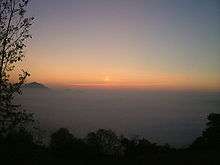False sunrise

A "false sunrise" (in the form of a fragmentary upper Sun pillar) as seen near Bologna, Italy in October 2008. Note the "lake-reflection" effect which is not real because there is no water in between.
A false sunrise is any of several atmospheric optical phenomena where the sun appears to have risen, whereas in reality it is still some distance below the horizon. A number of different atmospheric conditions can be responsible for this effect, all of which have in common that they divert the sunlight in such a way as to allow it to reach the observer's eye, thereby giving the impression that the light comes directly from the sun itself. The spread of light can sometimes be deceivingly similar to a real sun.
Several atmospheric phenomena that may alternatively be called a "false sunrise" are:
- Simple reflection of the sunlight off the bottom of the clouds.
- A type of ice crystal halo, such as an upper tangent arc or, more commonly, an upper sun pillar (similar to a subsun, but extending above the sun instead of below it). Like all halos, these phenomena are caused by the reflection and/or refraction of sunlight by ice crystals suspended in the atmosphere, often in the form of cirrus or cirrostratus clouds. The temperature on the ground is irrelevant to their occurrence, meaning that halos can be seen throughout the year and in all climates.
- A type of mirage; specifically the Novaya Zemlya effect. Restricted mainly to the polar regions, this phenomenon was named after its first observation on Novaya Zemlya during the third polar expedition led by Willem Barentsz in 1596/7, when the sun was seen above the horizon "in his full roundnesse"[1] two weeks prior to its predicted return after the polar night. The account, written by officer Gerrit de Veer, was met with general scepticism for centuries, and not until modern times was the effect proven to be genuine.[2]
The term "false sunrise" should not be confused with "false dawn", which is a term sometimes used to refer to the zodiacal light.
See also
- False sunset
- Mirage
- Sun pillar
- Halo (optical phenomenon)
- Upper tangent arc
- Subsun
- Novaya Zemlya effect
- Zodiacal light
References
- ↑ https://archive.org/stream/threevoyageswil00bekegoog#page/n353/mode/2up
- ↑ Siebren van der Werf, Het Nova Zembla verschijnsel. Geschiedenis van een luchtspiegeling ("The Novaya Zemlya phenomenon. History of a mirage"), 2011; ISBN 978 90 6554 0850.
This article is issued from Wikipedia - version of the 10/24/2016. The text is available under the Creative Commons Attribution/Share Alike but additional terms may apply for the media files.